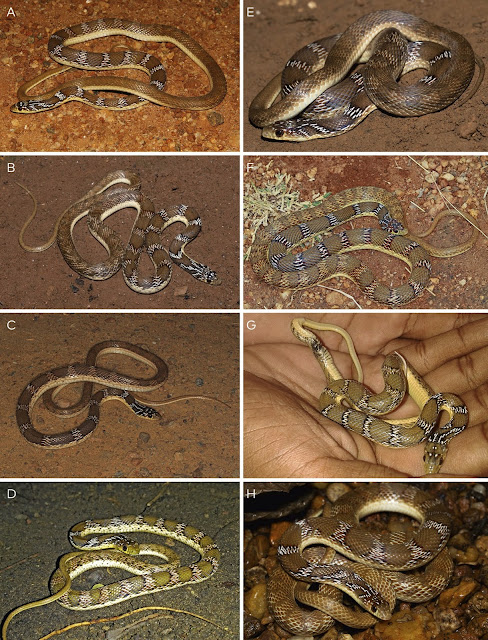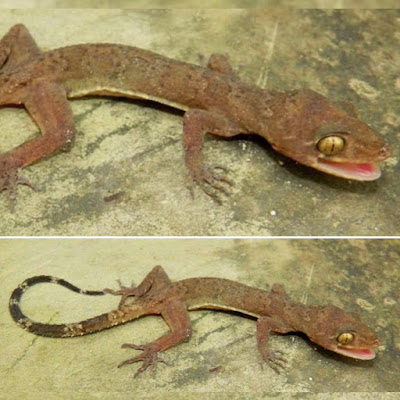[Most Recent Entries] [Calendar View]
Thursday, May 13th, 2021
| Time | Event | ||||
| 10:54a | [Herpetology • 2021] Revealing Two Centuries of Confusion: New Insights on Nomenclature and Systematic Position of Argyrogena fasciolata (Shaw, 1802) (auctt.) (Squamata: Colubridae), with Description of A New Species from India
Abstract Coluber fasciolatus Shaw, 1802 (today Argyrogena fasciolata auctt.) is the name used for a widespread terrestrial colubrid snake species inhabiting subtropical and tropical dry deciduous/thorn forests of South Asia from Pakistan to India, with unconfirmed records of distribution in Nepal, Bangladesh and Myanmar and a single doubtful record from the northern tip of Sri Lanka. During the past 200 years, A. fasciolata (common name Banded racer) has been placed in different genera, i.e. Tyria Fitzinger, 1826, Zamenis Wagler, 1830, Coryphodon Duméril, Bibron and Duméril, 1854, and Coluber Linnaeus, 1758 where it primarly remained until the mid 1960s and exceptionally until the year 2011. Three subsequently introduced names, viz. Coluber hebe Daudin, 1803, Coluber curvirostris Cantor, 1839, and Argyrogena rostrata Werner, 1924 were synonymized with C. fasciolatus shortly after its description. Based on a combination of characters including body pattern, external morphology and osteological differences Wilson (1967) reviewed the taxon fasciolatus Shaw and considered it as generically distinguishable, removed it from the then heterogeneous and undefined collective genus Coluber and assigned it to the resurrected genus Argyrogena Werner, 1924. Shaw’s (1802) description of C. fasciolatus was based exclusively on the information of Russell’s “Nooni Paragoodoo” published in 1796 in his “Account of Indian Serpents, collected on the coast of Coromandel; […]”. Our analysis of the original data and the depicted type specimen in Russell (1796) revealed that the name fasciolata was initially established for a species distinct from that currently known as the “Banded racer”, and that Russell’s data have been used simultaneously but unwittingly, for more than 150 years, as original source for two valid species from two different genera. Specimens of Banded racer found in the southeastern part of peninsular India are morphologically and genetically distinct from populations of the rest of the distribution area. These populations from central and southern Tamil Nadu state represent a different species, consequently described as a new species herein. Furthermore, examination of specimens of the Banded racer from different populations across its entire range, including the type specimen of the genus Argyrogena (A. rostrata Werner), reveals a similarity in morphology with the genus Platyceps Blyth, 1860. This was further supported by molecular data which demonstrates that the genus Argyrogena is nested within Platyceps. Keywords: Distribution, Lycodon fasciolatus comb. nov., morphology, Platyceps josephi sp. nov., Platyceps plinii comb. nov., Serpentes, South Asia, systematics Platyceps plinii (Merrem, 1820) comb. nov. – Banded racer Platyceps josephi sp. nov. – Joseph’s racer Diagnosis: A medium sized (maximum total length 951 mm) snake with countersunk lower jaw; dark brownish dorsum; head with irregular white spots, two slanting roughly “∏” shaped white markings with black edges on either side, starting on the back of the head (behind parietals) extending into the body, almost the length of head; 13–18 prominent white bands in the anterior region of the dorsum in both juveniles and adults; 34–48 total bands on the body in both juveniles and adults; 23:21(exceptionally 23):16–18 smooth dorsal scale rows; 189–218 ventrals (males: 192–197; females: 189–216); 76–88 subcaudals (males: 83–88; females: 76–88); cloacal plate divided; tail without bands and underside creamish. Its dentition is characterized by 12–16 maxillary teeth, the last two enlarged and separated by a diastema, 9–11 palatine teeth, 14–15 pterygoid teeth and 15–16 mandibular teeth. Platyceps josephi sp. nov. shows most similarities with its sister taxon P. plinii in regard to pholidosis and colour pattern but can be distinguished from the latter by its lower number of midbody dorsal scale rows (21 vs. 23), its lower mean value of ventral scales (202 vs. 214), its lower mean value of subcaudal scales (82 vs. 87) and its lower mean of the sum of ventral and subcaudal scales (285 vs. 304), the presence of the clearly demarcated two slanting roughly “∏” shaped white markings on the back of head vs. absence of such markings and distinct white bands on the dorsum in both juveniles and adults vs. ontogenetic change, i.e. bands present in juveniles only, but usually absent or faded in adults. Additionally, Platyceps josephi sp. nov. differs from P. plinii in variation of mitochondrial DNA sequences. With pairwise uncorrected p-distances varying 4–5% in cytb & ND4 and 3% in 16S. It is also clear from our thorough verification of distribution that these two species only have a minor range overlap in northeastern Tamil Nadu (Fig. 1 Map). Etymology: The specific epithet is a patronym of late Mr Naveen Joseph. Naveen was a naturalist from Tuticorin, well known for his research on reptiles, particularly snakes in that region. He was a friend of VD, SN, and GM and helped them collect specimens of the new species. Suggested English name: Joseph’s racer. Vernacular name: In various parts of Tamil Nadu state this snake is called by the name “Odugali Pambu” “ஓடுகாலிப்பாம்பு”. It is a portmanteau word in Tamil language “Odugali” is often used to address someone “who doesn’t stay at home and elopes” and “Pambu” is the word for “snake”. Distribution: Platyceps josephi sp. nov. is so far only known from Tamil Nadu state, India (see Fig. 1 Map). It is reported from the Anaimallai Hills and different localities within the districts of Coimbatore (Anaikatti, Coimbatore, Pollachi), Dindigul (Batlagundu), Kanyakumari (Maruthuvazhmalai), Karur (Karur), Madurai (Madurai, Vadipatti), Salem (Salem), Theni (Meghamalai Hills), Thoothukudi (Tuticorin), Tirunelveli (Coutrallam, Manimutharu, Tirunelveli) and Villupuram (Auroville) (see Appendix 9 Gazetteer and Appendix 10).
V. Deepak, Surya Narayanan, Pratyush P. Mohapatra, Sushil K. Dutta, Gnanaselvan Melvinselvan, Ashaharraza Khan, Kristin Mahlow and Frank Tillack. 2021. Revealing Two Centuries of Confusion: New Insights on Nomenclature and Systematic Position of Argyrogena fasciolata (Shaw, 1802) (auctt.), with Description of A New Species from India (Reptilia: Squamata: Colubridae). Vertebrate Zoology. 71: 253-316. DOI: 10.3897/vz.71.e64345 | ||||
| 11:07a | [Herpetology • 2021] Cyrtodactylus ngati • First Record of the Cyrtodactylus brevipalmatus Group (Squamata: Gekkonidae) from Vietnam with Description of A New Species Abstract A new species of the genus Cyrtodactylus is described from Dien Bien Province, northwestern Vietnam based on morphological and molecular data. Cyrtodactylus ngati sp. nov. can be distinguished from remaining congeners by the following combination of characters: maximum SVL 69.3 mm; dorsal pattern consisting of six dark irregular transverse bands between limb insertions; inter-supranasals one; dorsal tubercles present on occiput, body, hind limbs and on first half of tail; 17–22 irregular dorsal tubercle rows at midbody; lateral folds clearly defined, with interspersed tubercles; 32–38 ventral scales between ventrolateral folds; 13 precloacal pores separated by a diastema of 5/5 poreless scales from a series of 7/7 femoral pores in enlarged femoral scales; precloacal and femoral pores absent in females; 1–3 postcloacal tubercles on each side; transversely enlarged median subcaudal scales absent. In the molecular analyses, the new species is shown to be the sister taxon to C. interdigitalis from Thailand. This is the 47th species of the genus Cyrtodactylus and the first member of the C. brevipalmatus species group recorded from Vietnam. Keywords: Reptilia, Cyrtodactylus ngati sp. nov., morphology, phylogeny, taxonomy, northwestern Vietnam Dzung Trung Le, Saly Sitthivong, Tung Thanh Tran, L. Lee Grismer, Truong Quang Nguyen, Minh Duc Le, Thomas Ziegler and Vinh Quang Luu. 2021. First Record of the Cyrtodactylus brevipalmatus Group (Squamata: Gekkonidae) from Vietnam with Description of A New Species. Zootaxa. 4969(3); 492–510. DOI: 10.11646/zootaxa.4969.3.3 Cyrtodactylus ngati, một loài mới cho khoa học! Tiếp nối hướng nghiên cứu của thầy PGS.TS. Lê Nguyên Ngật tại Trường Đại học Sư phạm Hà Nội khi thầy đã về hưu, bản thân đã luôn tâm nguyện cố gắng và không ngừng vun đắp những giá trị gắn liền với tên thầy và cố GS. Trần Kiên tại ngôi trường này. Giờ đây, khi rẽ hướng sang một lĩnh vực mới của giáo dục, những giá trị đó xin nương nhờ các thế hệ tiếp nối. Với công trình khoa học trên tạp chí của New Zealand, học trò và các đồng tác giả vinh dự dùng tên thầy để đặt tên cho loài mới - Thằn lằn ngón ngật, Cyrtodactylus ngati. Ngat’s Bent-toed Gecko, a new species, we just described from Pa Thom moutain, Dien Bien Province, northwestern Vietnam. We name this new species in honor of our colleague, Assoc. Prof. Dr. Ngat Nguyen Le, Hanoi National University of Education, in recognition of his contribution to herpetological research in Vietnam. |
| << Previous Day |
2021/05/13 [Calendar] |
Next Day >> |











